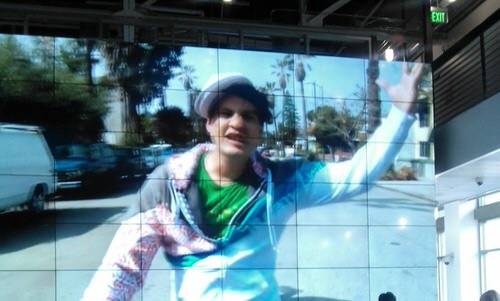
Far from the Walk of Fame or the fabled sign, this is not Hollywood. Too far southeast from the beaches filled with silicon tech and silicone bodies, we’re miles away from the beaten path. In a converted helicopter hangar once owned by Howard Hughes, step into the home of YouTube’s new creative space. Could this be the new home of L.A. tech, nestled in sleepy Playa Vista? If you’re into online video, and lucky enough to get access to the Google-owned facility, the answer may surprise you.
With fresh, wide-eyed faces, collaborative accommodations, and name tags galore, the YouTube space feels more like a college campus than a production facility. But that’s the point. Welcome to Day One of the inaugural incubator class. Welcome YouTubers. (Up till now, the space was used only for occasionally workshops, with the likes of Rainn Wilson and Amy Poehler.)
Through The Looking Glass

It’s got a Charlie and the Chocolate Factory feel that you can’t shake. The 41,000-square-foot facility smells, looks and feels like money – it’s backed by Google, after all, and subtle reminders and signage are everywhere. There’s a 6,000-foot catwalk circling the building, a fireman’s pole for quick access to the ground floor, and 2 million feet of fibre-optic cable running under the floor.

Above the check-in desk hang 48 video screens stacked on top of each other to form a jumbotron, playing a continuous feed of video. There are arcade games in one corner of the cavernous atrium, piles of food sitting in an adjoining open kitchen. The oldest visible person can’t have been born before 1980. Most look like they were hatched in the ’90s.

Everyone wears name tags, even staffers, who seem just as awed by the fancy digs as the stream of young creators who check-in and get their name badges like worker bees or students on the first day of school. Because that’s what today is: Day one of the space’s first incubator class.
Some 25 teams of YouTube “partners” are the first test batch of what can be legitimately dubbed the newest accelerator in town. Except this one doesn’t give you any money, or claim ownership of your final product. Instead, it offers the tools to make more professional productions, and strategy to build and grow audiences– while linking with creators on a profit share. When it comes to money, it’s becomes hard to pin down just how much they share as YouTube is reticent to make numbers public. According to online searches, partners make in the neighborhood of $2 to $5 per thousand views on their videos and about $0.01 per thousand channel views. But when asked to confirm these numbers, Google spokespeople responded that they don’t make public financial details with partners. “The ad rates (are) different for many reasons, so that’s not accurate. YouTube doesn’t share those various rates (again that depend on many factors) publicly. The rev share is always ‘majority goes to the partner’ and that much is consistent and public.”
Most people won’t make enough to quit their day job, and critics have said that this model is exploitive. For most people, that’s probably true. But not this group. These are very much the outliers, handpicked by YouTube based on audience size and diversity.
The space’s first resident, Freddie Wong, boasts more than 4.3 million subscribers and 785 million video views on his channel. There’s big money on the table for Wong. And he’s taking it.
YouTube is letting Freddie build a new soundstage for season two of his scripted series, Video Game High School. And it didn’t even have to spend a penny. Neither did Wong. He raised the money through a Kickstarter project and private investments.

Specs
There’s a a 1,500 square foot sound stage geared towards live music, a 47-seat screening room, three freshly painted green-screen rooms, an editing bay, live feed control rooms, a Next Lab to help audience development, and a “back lot” filled with rentable cameras and equipment. And there’s a palpable do-it-yourself, entrepreneurial feel that pervades the entire building.

“My mom should be able to walk in here and make a YouTube video,” explained Kathleen Grace, the space’s manager of production and programming.
The hours are 9am to 9pm, 6 days a week (on Sunday, they rest).
Partner Talk With Freddie Wong

Freddie Wong slides down the fireman’s pole and walks over. He sits at a long table opposite from me, adjusts his glasses, musses his long hair and apologizes for intermittent coughs. He’s getting over a cold.
Wong says online video is at a turning point. He says it’s moving from short and viral to more long form, higher-production-value content. At the same time, keeping creative control and direct access to fans is pushing the medium farther and farther away from the traditional video distribution system.

The involvement of Wong with YouTube, and his distaste for the studio system, is evidence of that. “As a creator, to be able to take [content] direct to our audience is something you’ve never had before,” Wong says.
How to bring media direct to the consumer with a fiscal model that works for both sides, is the big unanswered question. Wong admits the money side is still a work in progress, but when asked if he would take a rich deal with a big-name production company or television studio, he shakes his head emphatically. “What’s actually being offered?” he questioned.
Wong says it’s not all about the money, and creative control is a major factor. That’s why he wants to stay in this space, with YouTube. He’s predicting major gains for his upcoming new season, and his partnership with the online video giant.
“We’re kind of like the guinea pigs,” he says smiling, about his four-man team. “If you can handle us, you can handle anyone.”
Photos By Adam Popescu.

















